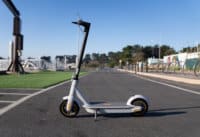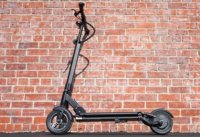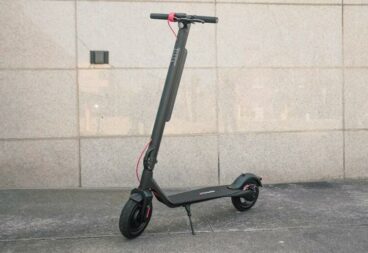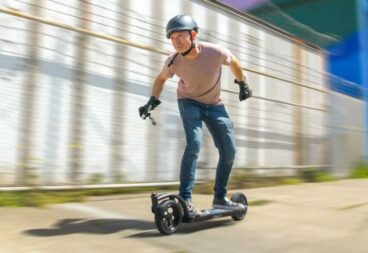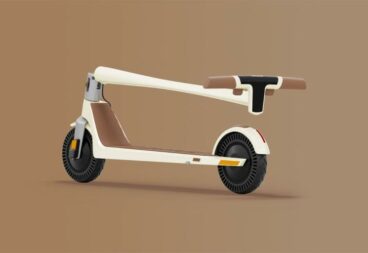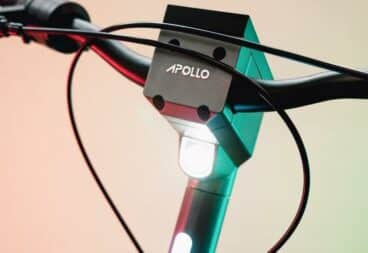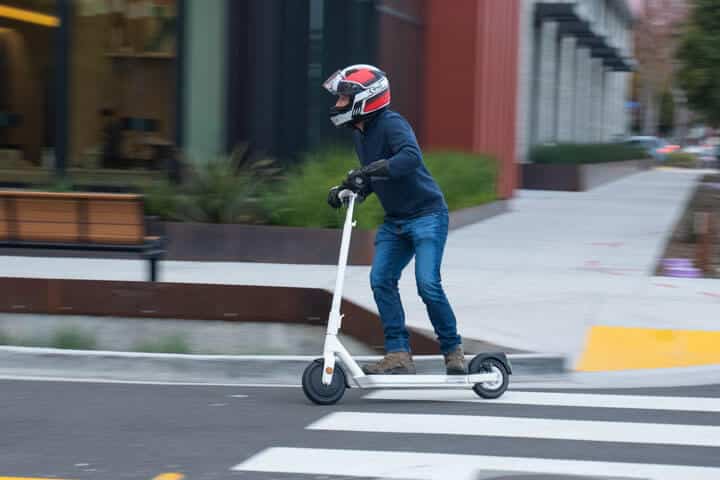
In this review of the Okai Neon, we spill the beans about a brand new, easy to ride, beginner scooter from a “secret” scooter company that’s poised to be the next Segway Ninebot.
Technical Specification
| Tested top speed: 16.0 mph* | |
| Tested range: 13.8 mi* | |
| Weight: 39 lb* | |
| Max rider weight: 220 lb | |
| Water resistance: IPX5 |
Highlights
| Modern LCD Display and Cool Lighting Features | |
| Excellent Build Quality | |
| Excellent Folding Mechanism | |
| Lack of Suspension (Though it Makes Up For it in Some Ways) | |
| Stopping Distance Could Be Better |
Our content is independent, but buying through our links may earn us a commission.
Summary
Want to support our hard work? Subscribe to our channel!
Our take: Everything we liked about the Ninebot Max G30LP, but tuned for new riders and not boring.
Shots fired.
Rental scooter giant, Okai, has launched its first scooter designed specifically for private ownership and it’s right on target: easy to ride, reliable, and the best looking new scooter since the Unagi One.
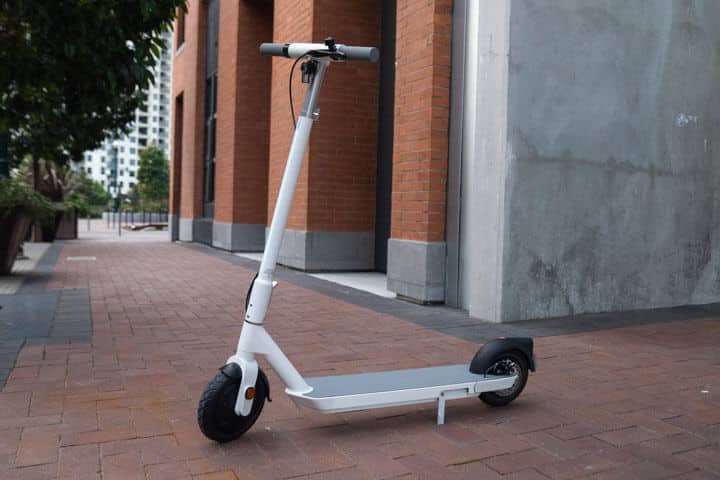
The Neon ES20 isn’t as light and portable as the old-school Xiaomi M365, and doesn’t have the range of the larger Ninebot Max G30, but we think the Neon’s stability, ride quality and thoroughly modern design (including a user-friendly app) put it squarely in the goldilocks zone for new riders.
The Neon’s acceleration and braking are definitely more laid back than sporty, but it’s got power where you need it: hills.
On our test hill, it out-climbed every 250 W scooter we’ve tested, plus 17 other scooters with motors rated 300 W to 500 W! Sustaining 12 mph to 15 mph up city hills was no problem with a 165 lb rider, plus 12 lbs of gear.
Parked next to the M365 and G30, the Neon’s looks are clearly next-generation. And in this case, what you see is what you get: The Neon is so 2022.
Best Alternatives and Competitors
Comparison scooters section Model
Top Speed**
Range**
Weight**
Price
Apollo Air Pro
18.8 mph
17.7 mi
37 lb
$799
Fluid Freeride Horizon (13 Ah)
24.0 mph
26.0 mi
39 lb
$849
Is It Good for Bigger, Heavier Riders? -No.
On flat ground, the Neon gets points for its huge deck, big comfy grips, relatively tall handlebars, and rear suspension.
However, it doesn’t receive the Big Dawg seal of approval for all-around use.
Our resident big dawg is above the max rider weight of 220 lbs, and in spite of being a strong hill climber for its size, for riders at or above the weight limit, steep hills would be a challenge.
The Okai Neon is not big dawg approved.
The EMOVE Cruiser and Apollo Explore are good alternatives for Big Dawgs, who are new riders.
Okai Scooter Review
Performance Summary
Acceleration
The Okai app gives you control over both the Neon’s top speed and acceleration, but even when set to the most aggressive riding mode, the thumb throttle is easy for new riders to use.
With a zero to 15 mph time of , its acceleration is definitely more laid back than sporty, but I wouldn’t say it’s slow. To put it in perspective, only one of the 7 GoTrax scooters we’ve ever tested will do 0 to 15 mph faster than this.
Hill Climb
Despite its laid-back acceleration, the Neon is a surprisingly strong hill climber: which is good, since whether you’re a new rider or experienced, no one wants to get off and push.
In our 10% grade hill climb, the Neon beat every 250 W scooter we’ve ever tested.
It also beat 17 other scooters rated for higher power (up to 500 Watts) and averaged a satisfying 11 mph to 14 mph on more typical 4 to 6% grade city hills.
Top Speed
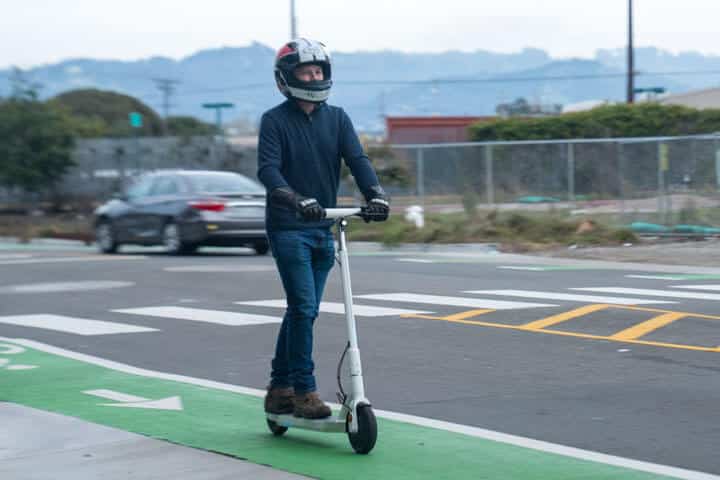
The ESG certified top speed of the Neon is , which exactly matches the claimed and indicated top speed. It’s rare for a scooter speedometer to be this accurate, most overestimate by 5 to 10%.
It’s fast enough to pass almost every bike in the bike lane but slow enough to help new riders stay out of trouble.
An interesting feature carried over from Okai’s rental scooters: when going down hill, the Neon will automatically apply a small amount of regenerative brake to keep you under the maximum speed.
Range
The Neon covered in top performance mode on the ESG range test course before shutting down; very similar to the 13.5 miles we covered on smaller Ninebot Max G30LP.
It makes the most of the available range, sustaining full speed until the last 1.5 miles, then dropping to 80% of full speed toward the very end.
By the way, any range test that doesn’t end with a scooter being pushed home, isn’t a real range test. All ESG range tests start with a full charge and end with a long walk back from the test loop after the scooter cuts off.
Braking
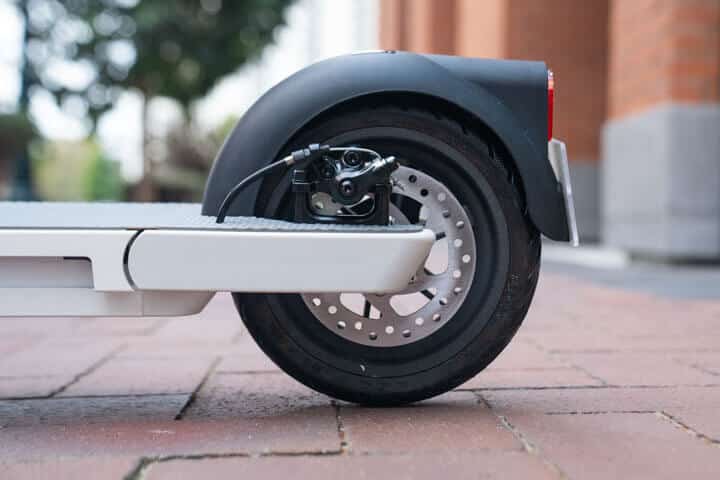
Our Neon came out of the box with its brakes perfectly adjusted and ready to use, which isn’t the case with many scooters. While the measured braking distance from 15 mph was unremarkable at ; what we like, especially for new riders, is that the front wheel’s electronic braking makes it impossible to flip over forward, no matter how hard you grab the brake lever.
Ride Quality
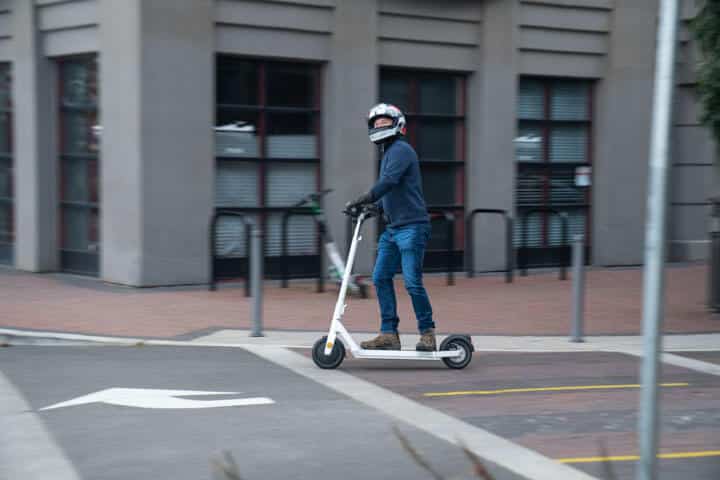
The Neon is easy to ride because it’s exceptionally stable and resistant to over-exuberant inputs.
The stem feels very solid with no detectable wobble and the large round grips feel like they would never come out of your hands if you hit an unexpected bump.
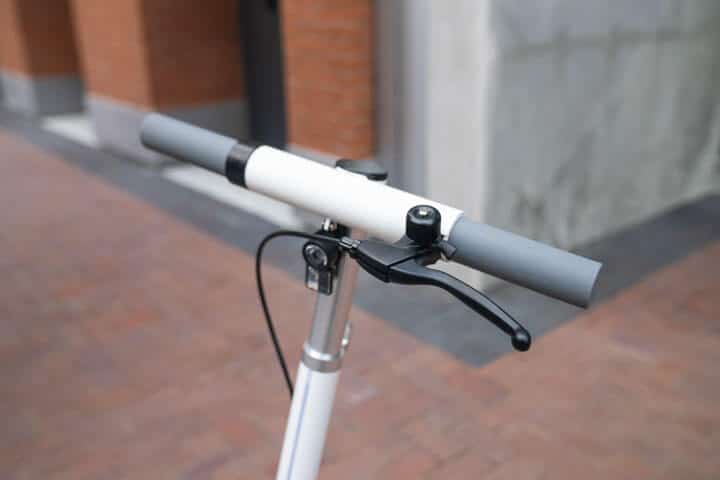
It was so stable, I even broke my own rule and spent a couple of minutes riding it one-handed.
I highly recommend not riding scooters one-handed as it’s one of the leading causes of crashes. That said, you’re more likely to get away with scratching your nose or adjusting your helmet while riding a Neon than just about any other scooter.
Okai Neon Features
Portability
The scooter’s white color and light gray deck make me feel like it would be easier to sneak it into a dentist appointment or elevator without receiving sideways glances.
Folding and unfolding are straightforward, and my favorite part is that you don’t need to fiddle around with latching the bars to the deck. Everything just locks into carrying-position automatically when folded, and stays latched.
Speaking of trunks, the measured length of the Neon made me think it would be a tight squeeze, but it dropped into our Honda Civic test-trunk more easily than the 46 in length, or weight suggest.
We should point out that the measured weight was significantly different from the specified weight, blindly parroted by other reviews. We checked it on two shipping scales and they both agreed to within 11 grams.
It’s a 39 lb scooter, which for me means that it’s comfortable to carry up about three flights of stairs before the weight gets bothersome.
Cockpit
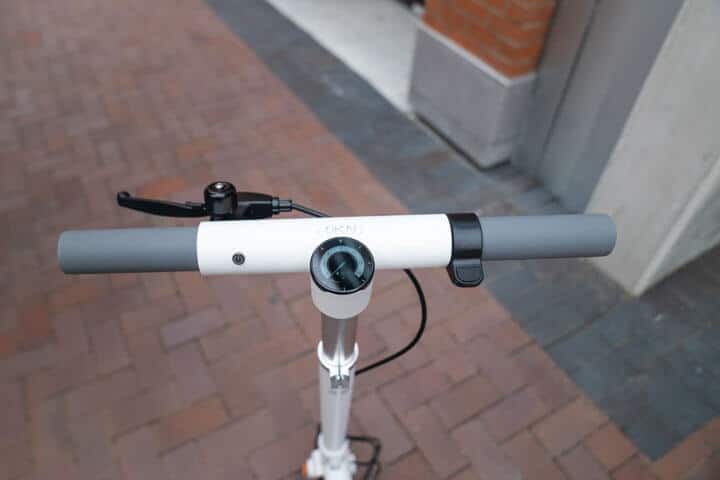
The cockpit of the Neon is ultra-modern and ultra-clean. So much so, that almost every scooter in this price class suddenly feels painfully old. Parking them next to each other is like holding an old digital watch next to an Apple watch, the contrast is striking.
The Okai app also lets you toggle between three different gauge faces and there’s even a cool “filling up” animation on-screen while charging.
Lights
The Neon has better swag-lights than anything in its class, and the app gives you a deeper level of control than we’re used to seeing. You can set the ambient lights to switch between different colors and patterns, depending on whether it’s locked, unlocked, or charging.
At the moment, there are bugs though: the speed-control for the swag lights is backward (slow = fast), and the biggest bug of all: with the current firmware, we weren’t able to get the app to work at all on the ESG-Labs Android phone. The scooter still functions fine without the app.
The headlight is high mounted, but not particularly bright. Considering that this is a scooter with a top speed of 16 miles per hour, it gets the job done.
Tires
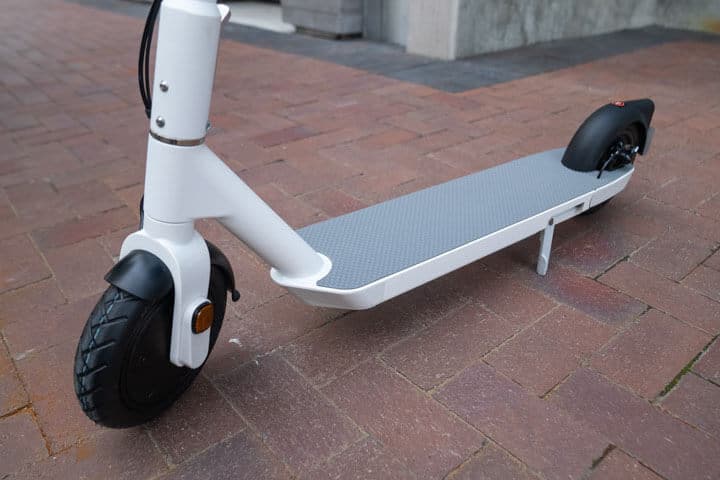
Here’s an odd detail we discovered. The spec sheet, and some reviews, report the front tire to be 8.5 inches in diameter, but it’s actually 9 inches. This is good because larger diameter tires feel better going over potholes, sticks, or other abrupt surface changes.
The diameter is confirmed by the “230” molded into the side of the tire, indicating tire diameter in millimeters.
The measured diameter of the rear tire, on the other hand, matches its spec of 8.5 inches.
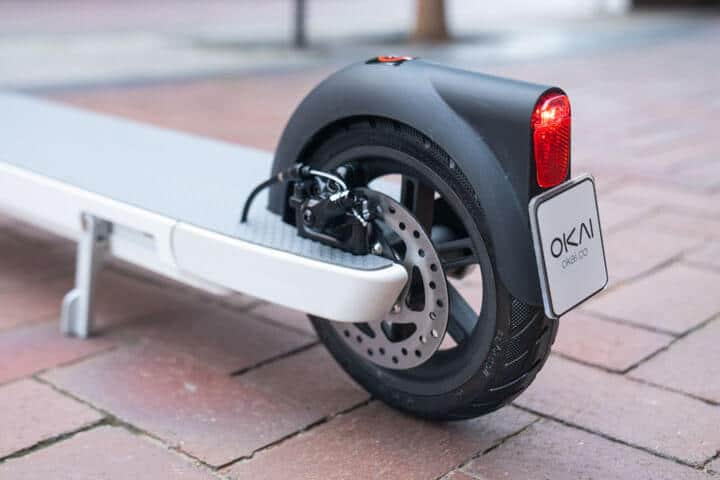
Speaking of rear tires.
Did you know, that’s where the vast majority of flats happen? Okai takes advantage of this fact by using a tubed-pneumatic front tire and solid rear tire, to optimize for ride quality and flat resistance.
Of course, while solid tires are flat-proof, the downside is a stiff/bumpy ride, but Okai solved this by giving the Neon rear suspension. You really have to look to see it, but it’s there and it works. As a result, the rear of the scooter actually feels a little smoother than the front, though dropping the front tire pressure from 50 psi to 45 would even things out.
Both tires are mounted on solid (non-split) rims. We physically checked.
Deck
The importance of deck length is often overlooked. The general rule is longer deck = better ride quality, and easier to ride. The Neon’s deck is very very long. At 22.0 inches it’s tied for the fourth-longest deck of any scooter we’ve ever tested.
There are two reasons why this matters: one, the wider you plant your feet front-to-back, the less it feels like you are tipping forward or backward when you brake or accelerate. And two, having more space just gives you more options as you figure out what foot positions work best for you.
Build Quality
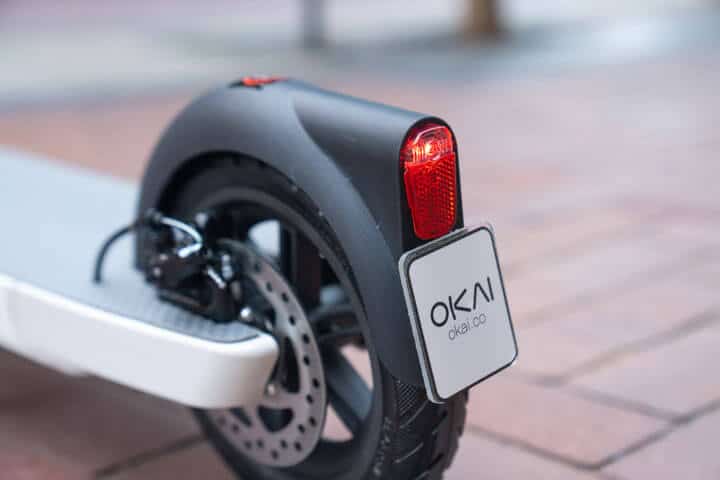
The best thing about knowing your scooter was designed by a company that makes rental scooters is; they’re going to build it to be as tough as a lamp post.
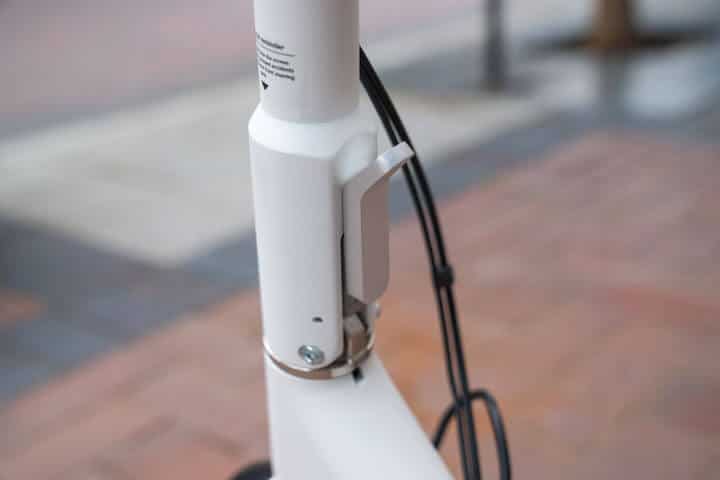
Before coming to ESG I ran repair warehouses for a couple major scooter rental companies. So, I’ve seen the kind of abuse that rental scooters take, and how quickly the scooter designs evolve as a result. That sort of evolution is further sped-along because Okai is big enough to make their own circuit boards, build and test their own battery packs and do some pretty serious component testing. Also anyone who includes a jump and water crossing in their test track is doing something right.
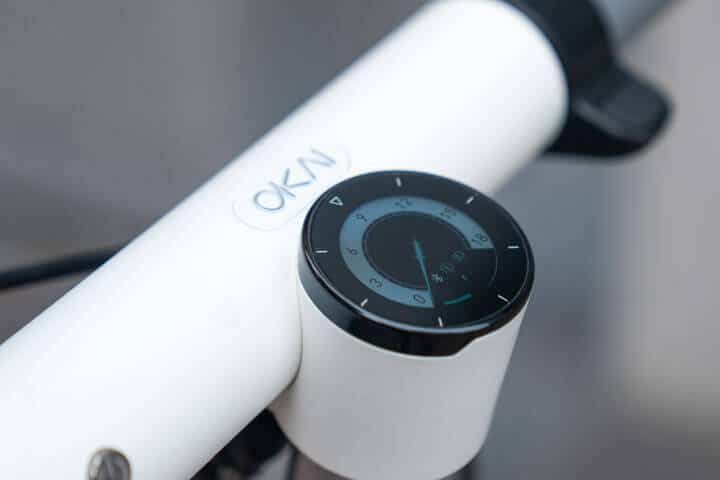
As we know from the Ninebot scooters, making an entire scooter that’s all about reliability, can come out about as exciting as an office printer. So we were happy to see some next-gen features as well, like the bright, color display, with three different modes, and an NFC reader.
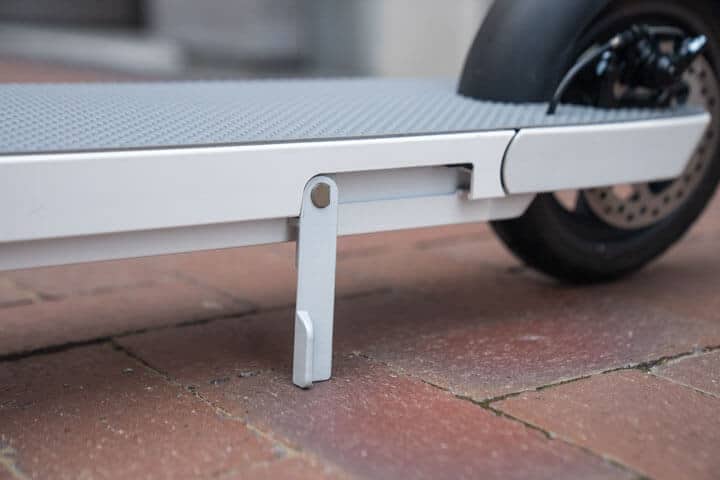
The whole design feels super modern and clean but more importantly, it just works. The kickstand is a good example. It folds away completely so it won’t hook your ankle while walking, but is still easy to kick down. It even has a nice sounding detent (a little spring-loaded ball bearing that locks it into place).
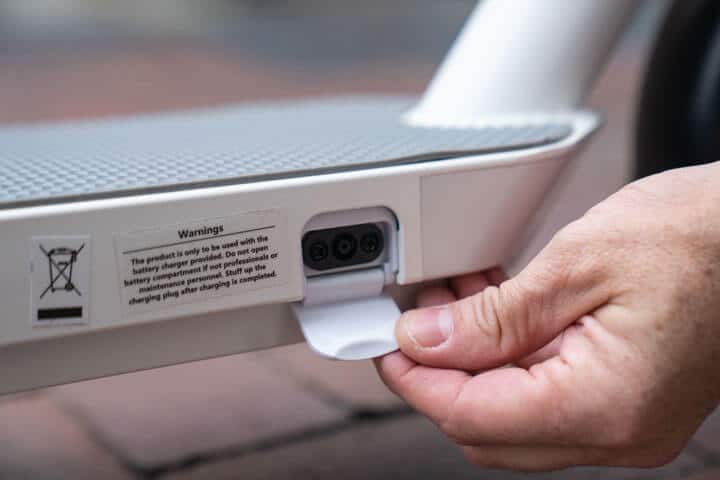
There’s also a bag hook, on the stem, but we recommend keeping your payload under 5 lbs or things may start feeling unbalanced.
There’s a bug in the app you need to know about. You have to close the app when you’re done riding your scooter for the day. Otherwise, the app will run in the background, trying to connect to a scooter that’s not there, and will eventually run your phone’s battery down.
We expect the app to be updated soon, especially since there are features, like the ability to turn off regenerative braking, that are shown on the screen, but aren’t yet enabled.
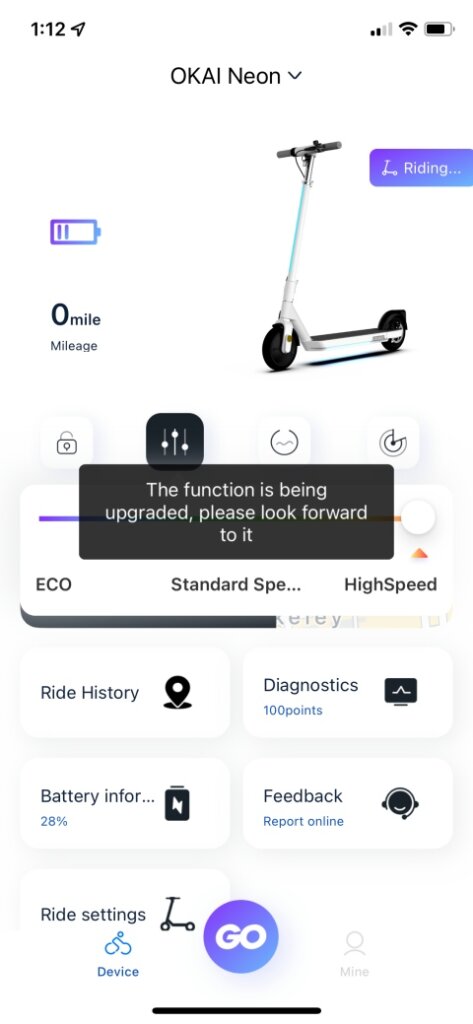
Since Okai makes rental scooters, which get ridden every day, rain or shine, it’s no surprise that the Neon has an IPX5 water resistance rating. The Neon’s fender protection is outstanding, and since it’s been raining basically every day since we received the scooter, I did the first of two range tests in the rain. The scooter held up fine, and the display looks really cool with water on it.
Okai Neon: Review Conclusions
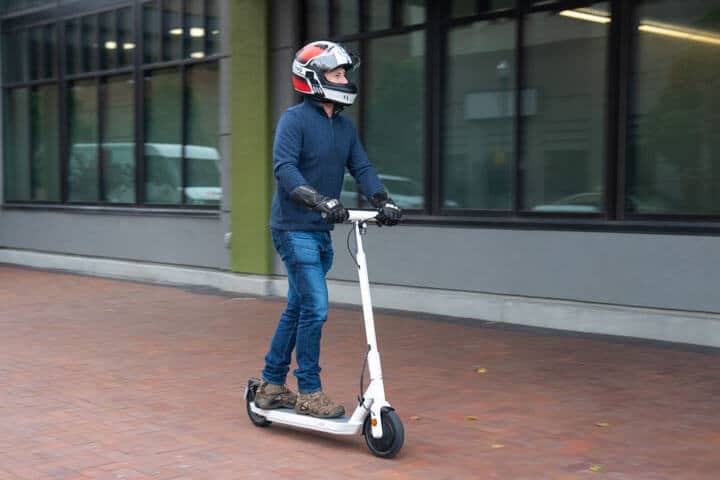
The Okai Neon ES20 is a pleasant surprise, from a giant scooter company that has finally decided to de-cloak.
While it’s not designed for big top speed or adrenaline-inducing acceleration, they’ve made a very good-looking scooter that’s easy to learn on, climbs hills better than most scooters its size, and judging by their rental scooters, we expect it to be as tough and reliable as a lamp post.
Our content is independent, but buying through our links may earn us a commission.
